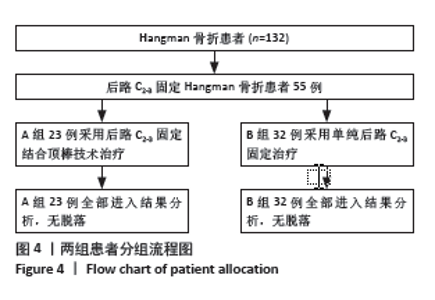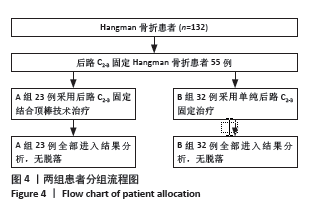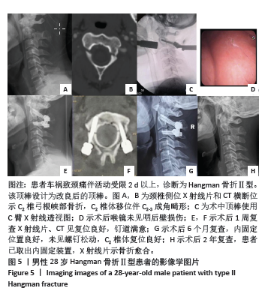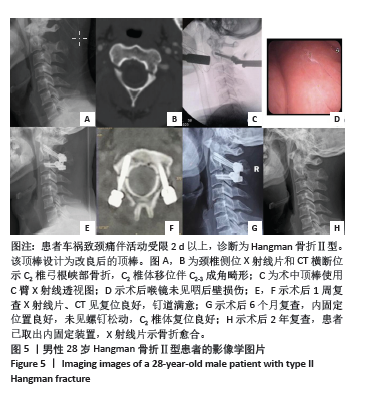Chinese Journal of Tissue Engineering Research ›› 2025, Vol. 29 ›› Issue (9): 1848-1854.doi: 10.12307/2025.120
Previous Articles Next Articles
Comparison of posterior C2-3 fixation combined with bucking bar technique and posterior C2-3 fixation alone in treatment of unstable Hangman fractures
Zhang Hao, Wang Qing, Zhang Jian, Li Guangzhou, Wang Gaoju
- Department of Orthopedics, Affiliated Hospital of Southwest Medical University, Luzhou 646000, Sichuan Province, China
-
Received:2023-11-27Accepted:2024-01-13Online:2025-03-28Published:2024-10-10 -
Contact:Wang Gaoju, Master, Associate chief physician, Department of Orthopedics, Affiliated Hospital of Southwest Medical University, Luzhou 646000, Sichuan Province, China Li Guangzhou, PhD, Associate chief physician, Department of Orthopedics, Affiliated Hospital of Southwest Medical University, Luzhou 646000, Sichuan Province, China -
About author:Zhang Hao, Master candidate, Physician, Department of Orthopedics, Affiliated Hospital of Southwest Medical University, Luzhou 646000, Sichuan Province, China -
Supported by:Luzhou Municipal People’s Government-Southwest Medical University Science and Technology Strategic Cooperation Project, No. 2020LZXNYDJ40 (to WGJ)
CLC Number:
Cite this article
Zhang Hao, Wang Qing, Zhang Jian, Li Guangzhou, Wang Gaoju. Comparison of posterior C2-3 fixation combined with bucking bar technique and posterior C2-3 fixation alone in treatment of unstable Hangman fractures[J]. Chinese Journal of Tissue Engineering Research, 2025, 29(9): 1848-1854.
share this article
Add to citation manager EndNote|Reference Manager|ProCite|BibTeX|RefWorks

2.3 基线资料比较 两组共55例患者均顺利完成手术及随访,术后随访(3.5±2.5)年。A组23例,其中男17例,女6例;平均年龄(44.5±15.4)岁 (22-75岁);Levine-Edwards分型:Ⅱ型19例,ⅡA型2例,Ⅲ型2例;ASIA分级:D级3例,E级20例。B组32例,其中男28例,女4例;年龄(46.3±15.4)岁(15-78岁);Levine-Edwards 分型:Ⅱ型27例,ⅡA型3例,Ⅲ型2例;ASIA分级:B级1例,C级1例,D级5例,E级25例。两组在性别、年龄、骨折类型、致伤原因、随访时间等方面相比,差异均无显著性意义(P > 0.05),具有可比性,见表2。"
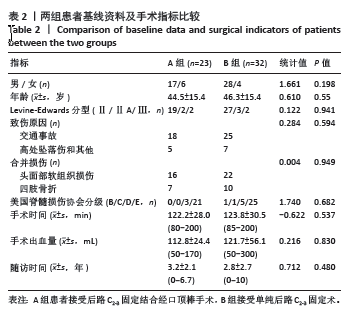
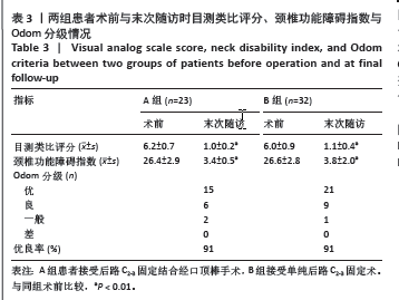
2.4 临床疗效及并发症比较 两组患者末次随访时颈痛及颈部活动受限等症状均较术前有明显改善。A组手术时间 (122.2±28.0) min (80-200 min),术前ASIA D级3例,术后神经损伤症状缓解,恢复至 ASIA E级;B组手术时间(123.8±30.5) min (85-200 min),术前ASIA B级恢复至ASIA D级1例,D级恢复至E级3例。两组患者手术时间和术中出血量比较差异无显著性意义(P > 0.05)。两组患者末次随访颈痛目测类比评分、NDI较术前显著改善(P < 0.05)。末次随访的Odom标准分级显示A组优良21例(91%,21/23),B组优良29例(91%,29/32),两组比较差异无显著性意义(P > 0.05),见表3。A组术后出现过轻度咽部疼痛4例,喉镜提示Ⅰ度黏膜损伤,术后1周均缓解消失。B组出现术后颈部疼痛1例,但不影响生活。两组患者均未出现植入物周围感染、过敏反应、免疫反应、排斥反应、神经功能恶化、切口感染等并发症。"
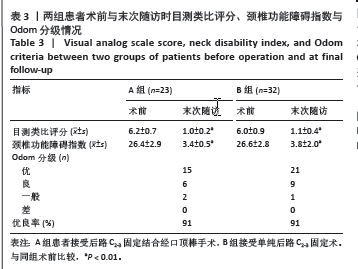
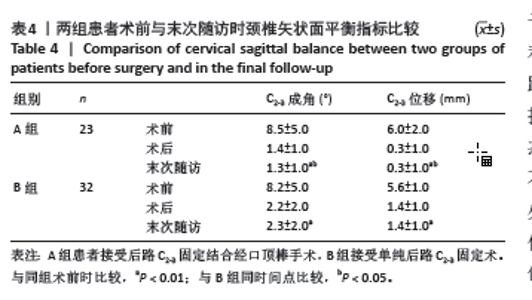
2.5 影像学比较 A组成功置入C2椎弓根螺钉46枚,C3椎弓根螺钉26枚,侧块螺钉20枚;B组成功置入C2椎弓根螺钉64枚,C3椎弓根螺钉38枚,侧块螺钉26枚,两组均未发现内固定松动、失败等情况。两组术前C2-3成角和位移差异无显著性意义(P > 0.05)。术后及末次随访时,两组C2-3成角和位移均较术前明显减小,差异有显著性意义(P < 0.01);术后和末次随访上述指标比较差异无显著性意义(P > 0.05)。术后及末次随访时,A组C2-3位移和成角较B组明显减小,差异有显著性意义(P < 0.05)。见表4。末次随访时, A组患者均没有发生残余畸形[14],B组中发生残余畸形4例(13%,4/32)。"
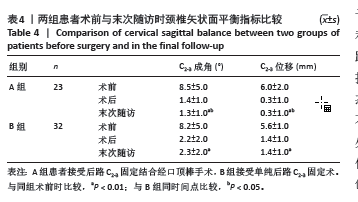
| [1] SCHOLZ M, KANDZIORA F, KOBBE P, et al. Treatment of Axis Ring Fractures: Recommendations of the Spine Section of the German Society for Orthopaedics and Trauma (DGOU). Global Spine J. 2018; 8(2 Suppl):18S-24S. [2] CHAUDHARY SB, MARTINEZ M, SHAH NP, et al. Traumatic atlantoaxial dislocation with Hangman fracture. Spine J. 2015;15(4):e15-e18. [3] AL-MAHFOUDH R, BEAGRIE C, WOOLLEY E, et al. Management of Typical and Atypical Hangman’s Fractures . Global Spine J. 2016;6(3): 248-256. [4] YUNDE A, FURUYA T, ORITA S, et al. Hangman’s Fracture in Geriatric Population: A Nationwide Multicenter Study in Japan. Global Spine J. 2023:21925682231216925. doi: 10.1177/21925682231216925. [5] PROST S, BARREY C, BLONDEL B, et al. Hangman’s fracture: Management strategy and healing rate in a prospective multi-centre observational study of 34 patients. Orthop Traumatol Surg Res. 2019; 105(4):703-707. [6] HUR H, LEE JK, JANG JW, et al. Is it feasible to treat unstable hangman’s fracture via the primary standard anterior retropharyngeal approach? Eur Spine J. 2014;23(8):1641-1647. [7] LI S, DU J, HUANG Y, et al. Comparison of the efficacies of TINAVI robot-assisted surgery and conventional open surgery for Levine-Edward type IIA (postreduction) hangman fractures. Sci Rep. 2023;13(1):15934. [8] 王清, 王松, 钟德君,等. 不稳定性Hangman骨折手术入路选择[J]. 中国脊柱脊髓杂志,2012,22(6):526-530. [9] LI G, WANG Q, LIU H, et al. Individual Surgical Strategy Using Posterior Lag Screw-Rod Technique for Unstable Atypical Hangman’s Fracture Based on Different Fracture Patterns. World Neurosurg. 2018;119: e848-e854. [10] ZHANG J, LI G, WANG Q. Is it feasible to treat unstable traumatic spondylolisthesis of the axis via posterior fixation without fusion? BMC Musculoskelet Disord. 2023;24(1):122. [11] JEONG DH, YOU NK, LEE CK, et al. Posterior C2-C3 Fixation for Unstable Hangman’s Fracture. Korean J Spine. 2013;10(3):165-169. [12] WANG S, WANG Q, YANG H, et al. A novel technique for unstable Hangman’s fracture: lag screw-rod (LSR) technique. Eur Spine J. 2017; 26(4):1284-1290. [13] 王高举, 王清, 王松,等. 后路椎弓根置钉顶棒技术治疗C2椎弓根骨折的疗效[J]. 中华创伤杂志,2017,33(4):327-331. [14] LI G, YANG Y, LIU H, et al. Residual Deformity After Anterior Cervical Discectomy and Fusion for Unstable Hangman’s Fractures. World Neurosurg. 2017;108:216-224. [15] MAGERL FP. Stabilization of the lower thoracic and lumbar spine with external skeletal fixation . Clin Orthop Relat Res. 1984;(189):125-141. [16] XIE N, KHOO LT, YUAN W, et al. Combined anterior C2-C3 fusion and C2 pedicle screw fixation for the treatment of unstable hangman’s fracture: a contrast to anterior approach only . Spine (Phila Pa 1976). 2010;35(6):613-619. [17] LI Z, LI F, HOU S, et al. Anterior discectomy/corpectomy and fusion with internal fixation for the treatment of unstable hangman’s fractures: a retrospective study of 38 cases. J Neurosurg Spine. 2015;22(4): 387-393. [18] BRISTOL R, HENN JS, DICKMAN CA. Pars screw fixation of a hangman’s fracture: technical case report. Neurosurgery. 2005;56(1 Suppl):E204; discussion E. [19] MAHMOUD A, SHANMUGANATHAN K, MONTGOMERY A. Surgical Management of Hangman’s Fracture: A Systematic Review. Int J Spine Surg. 2023;17(3):454-467. [20] 张帅,张引,李新武,等.两种非融合术式治疗Ⅱ型和Ⅱa型Hangman骨折的疗效比较[J]. 实用骨科杂志,2022,28(2):97-102. [21] SEO HY, KO JH, PARK JB, et al. Anterior C2-3 fusion surgery alone for highly displaced Hangman’s fracture with severe angulation of C2-3 of more than 30° . Clin Neurol Neurosurg. 2021;206:106701. [22] 勾瑞恩, 母心灵, 崔京福,等. 颈前路间盘切除植骨融合治疗不稳定Hangman骨折[J]. 中国矫形外科杂志,2021,29(14):1269-1272. [23] 陈荣滋, 郑耿阳, 王顺民,等. C2/C3颈椎前路椎间盘切除融合术治疗Hangman骨折对下位颈椎椎间盘高度及颈椎曲度的影响[J]. 脊柱外科杂志,2021,19(6):411-415. [24] 谭军,贾连顺,侯黎升,等. C2椎弓根拉力螺钉选择性治疗Hangman骨折[J]. 中华骨科杂志,2002,22(11):653-656. [25] JIN C, XIE N, REN Y, et al. How Does Cervical Sagittal Balance Change After Hangman Fracture Treated with Anterior or Posterior Approach Surgery? World Neurosurg. 2020;138:e767-e77. [26] XU D, GAN K, WANG Y, et al. Comparison of C2-3 Pedicle Screw Fixation With C2 Spinous Muscle Complex and Iliac Bone Graft for Instable Hangman Fracture. Front Surg. 2021;8:723078. [27] 阮汉江,金根洋,李新武,等.三种后路单节段固定方式治疗Ⅱ型Hangman骨折的生物力学性能[J]. 中国组织工程研究,2021,25(15): 2309-2314. [28] DUGGAL N, CHAMBERLAIN RH, PEREZ-GARZA LE, et al. Hangman’s fracture: a biomechanical comparison of stabilization techniques. Spine (Phila Pa 1976). 2007;32(2):182-187. [29] 徐昊,马迅. 手术治疗Ⅲ型Hangman骨折的研究进展[J]. 实用骨科杂志,2023,29(3):234-238. [30] 张腾飞,梅伟. Hangman骨折的诊断与治疗进展[J]. 中国骨与关节杂志,2021,10(4):281-286. [31] 方艳志, 徐志强, 迟寿远, 等. Hangman骨折两种气管插管全麻下短节段固定融合[J]. 中国矫形外科杂志,2023,31(16):1482-1487. [32] LONG Z, YU H, YANG H, et al. Biomedical analysis of four fixation systems in treatment of type II traumatic spondylolisthesis of the axis: a finite element analysis. Med Biol Eng Comput. 2024;62(3):843-852. [33] 雷舒澳, 王清, 李广州,等. 机动车事故致Hangman骨折的临床特征分析:一项基于多中心数据的回顾性研究[J]. 中国脊柱脊髓杂志, 2023,33(7):577-583. [34] LI G, WANG Q. Application of novel self-designed surgical tools for the safe C2 pedicle screw placement in 12 patients with Hangman fracture. Asian J Surg. 2023;46(6):2419-2420. [35] WANG J, CHEN H, CAO P, et al. Combined Anterior-Posterior Fixation and Fusion for Completely Dislocated Hangman’s Fracture: A Retrospective Analysis of 11 Cases. Clin Spine Surg. 2017;30(8): E1050-E1054. [36] WANG G, JIANG D, WANG Q, et al. A novel technique using a pedicle screw and bucking bar for the treatment of hangman’s fracture. Orthop Traumatol Surg Res. 2019;105(4):709-711. [37] IYER S, NEMANI VM, NGUYEN J, et al. Impact of Cervical Sagittal Alignment Parameters on Neck Disability. Spine (Phila Pa 1976). 2016; 41(5):371-377. [38] EFFENDI B, ROY D, CORNISH B, et al. Fractures of the ring of the axis. A classification based on the analysis of 131 cases. J Bone Joint Surg Br. 1981;63-B(3):319-327. [39] TAKEUCHI K, YOKOYAMA T, ABURAKAWA S, et al. Inadvertent C2-C3 union after C1-C2 posterior fusion in adults. Eur Spine J. 2006;15(3): 270-277. [40] 金晨, 任亦龙, 徐委,等. 两种不同手术方式治疗不稳定性Hangman骨折的疗效对比 [J]. 中国脊柱脊髓杂志,2020,30(1):20-29. [41] KONG W, YANG X, LI Z, et al. Analysis of the Cervical Sagittal Alignment in Patients with Unstable Hangman Fracture Under C2-3 Anterior Discectomy and Fusion. World Neurosurg. 2020;137:e1-e8. [42] 周虹羽, 汪姝玥, 王清,等. 解剖型顶棒辅助后路C2椎弓根钉内固定治疗寰枢椎不稳对咽后壁软组织的影响[J]. 中国骨与关节损伤杂志,2022,37(3):246-249. |
| [1] | Chen Xi, Tang Tao, Chen Tongbing, Li Qing, Zhang Wen. Mechanical stability of intertrochanteric fracture of femur with different internal fixation systems [J]. Chinese Journal of Tissue Engineering Research, 2025, 29(9): 1783-1788. |
| [2] | Huang Haobo, Liang Xinyuan, Ye Guozhong, Xie Qingxiang, Su Boyuan. Suture tape and headless compression screws in treatment of Lisfranc injury with comminuted fractures of the first and second proximal metatarsal bones [J]. Chinese Journal of Tissue Engineering Research, 2025, 29(9): 1803-1809. |
| [3] | Su Lintao, Jiang Jianfeng, Ma Jun, Huang Liangliang, Lei Changyu, Han Yaozheng, Kang Hui. Precise application of O-arm navigation system in thoracolumbar fractures with developmental pedicle stenosis [J]. Chinese Journal of Tissue Engineering Research, 2025, 29(9): 1855-1862. |
| [4] | Gao Zhenyang, Zeng Xiuan, Yang Qibing, Kou Xianshuai, Wang Kejing, Li Meng. Computer-simulated repositioning combined with pelvic reduction frame for treatment of anteroposterior compression-III pelvic fractures [J]. Chinese Journal of Tissue Engineering Research, 2025, 29(9): 1870-1875. |
| [5] | Yu Ming, Wang Wen. Posterior cruciate ligament tibial attachment point avulsion fracture: materials, implants, and internal fixation techniques in arthroscopic treatment [J]. Chinese Journal of Tissue Engineering Research, 2025, 29(4): 872-880. |
| [6] | Sheng Wenbo, Liu Bingli, Li Sibo, Ao Rongguang, Yu Baoqing. Cement-augmented short-segment percutaneous pedicle screw fixation for the stage II Kümmell’s disease [J]. Chinese Journal of Tissue Engineering Research, 2025, 29(34): 7286-7292. |
| [7] | Wang Lei, Li Chengsong, Zhang Shenshen, Wang Qing. Finite element analysis of biomechanical characteristics of three internal fixation methods in treatment of inferior patellar fracture [J]. Chinese Journal of Tissue Engineering Research, 2025, 29(33): 7048-7054. |
| [8] | Xu Xin, Wurikaixi·Aiyiti, Lyu Gang, Maimaiaili·Yushan, Ma Zhiqiang, Ma Chao. Finite element analysis of four different internal fixation methods for complex acetabular double-column fractures [J]. Chinese Journal of Tissue Engineering Research, 2025, 29(33): 7063-7071. |
| [9] | Hu Chaoran, Cen Chaode, Yang Yang, Zhou Cheng, Huang Huaxian, Yuan Honghao, Luo Qin, Cao Yongfei. 3D printing assisted minimal invasive plate osteosynthesis versus intramedullary nail for treatment of AO12-C middle-proximal humeral fractures [J]. Chinese Journal of Tissue Engineering Research, 2025, 29(33): 7116-7122. |
| [10] | Yang Wanzhong, Ma Rong, Guo Wei, Wang Zhiqiang, Yang Wei, Chen Zhen, Wang Zemin, Zhang Honglai, Ge Zhaohui. One-stage posterior hemivertebra resection and pedicle screw fixation in treatment of congenital scoliosis: a 2-year follow-up of correction effect [J]. Chinese Journal of Tissue Engineering Research, 2025, 29(33): 7173-7180. |
| [11] | Hu Liuchao, Luo Yiwen, Wu Zhifang. Fracture line map characteristics of distal radius fractures involving dorsal articular surface: effective fixation with screws for postoperative displacement [J]. Chinese Journal of Tissue Engineering Research, 2025, 29(3): 524-530. |
| [12] | Liu Xiaoyin, Zhang Jianqun, Chen Zhen, Liang Simin, Wang Zhiqiang, Ma Zongjun, Ma Rong, Ge Zhaohui. Short-term efficacy of oblique lateral interbody fusion combined with lateral plate fixation in treatment of single-level lumbar degenerative disease [J]. Chinese Journal of Tissue Engineering Research, 2025, 29(3): 531-537. |
| [13] | Li Zhenggang, Shang Xuehong, Wu Zhang, Li Hong, Sun Chaojun, Chen Huadong, Sun Zhe, Yang Yi. Finite element analysis of three internal fixation modalities for treatment of Pauwels type III femoral neck fractures under different loading conditions [J]. Chinese Journal of Tissue Engineering Research, 2025, 29(3): 455-463. |
| [14] | Mutalipu·Silamujiang, Yusufu·Reheman, Ren Zheng, Alimujiang·Yusufu, Ran Jian, Wang Jian. Finite element analysis of three internal fixation methods for treating Pauwels III femoral neck fractures with anterior medial bone defects [J]. Chinese Journal of Tissue Engineering Research, 2025, 29(27): 5721-5727. |
| [15] | Liu Yuhang, Li Hongyu, Wang Yong, Wang Fengxing. Visual analysis of application of three-dimensional finite element method in femoral head necrosis [J]. Chinese Journal of Tissue Engineering Research, 2025, 29(27): 5933-5940. |
| Viewed | ||||||
|
Full text |
|
|||||
|
Abstract |
|
|||||
